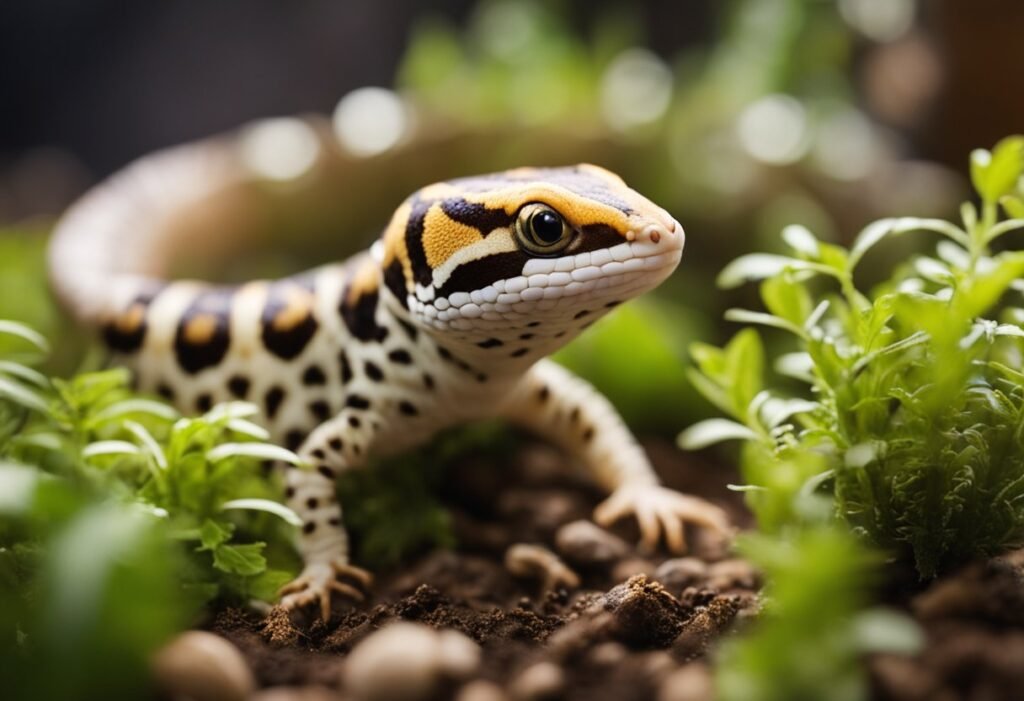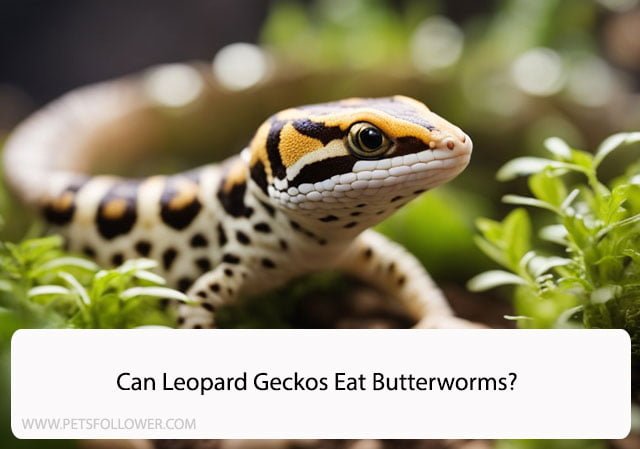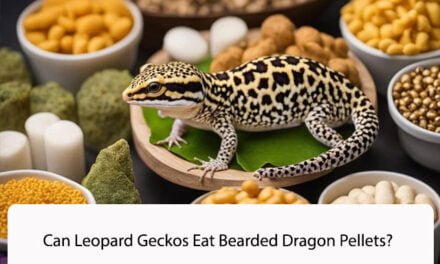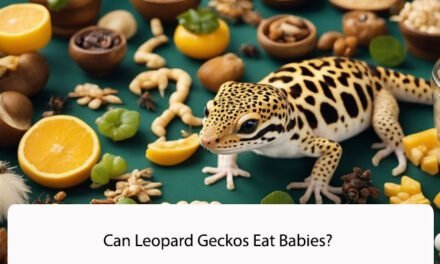Leopard geckos are popular pets due to their docile nature, low maintenance, and striking appearance. As with any pet, it’s important to provide them with a nutritious and balanced diet to ensure their health and well-being. While there are a variety of feeder insects available, one question that often arises is whether leopard geckos can eat butterworms.
Butterworms, also known as trevo worms, are the larvae of the Chilean moth. They are a popular feeder insect for a variety of reptiles, including bearded dragons and chameleons. However, when it comes to leopard geckos, the answer is not as straightforward. While butterworms can be a nutritious treat for leopard geckos, they should not be the sole source of their diet. In this article, we will explore the nutritional value of butterworms and how they can be incorporated into a leopard gecko’s diet.
Dietary Needs of Leopard Geckos

As responsible pet owners, we need to ensure that our leopard geckos are receiving a balanced and nutritious diet that meets their dietary needs. Leopard geckos are insectivores, which means that their diet should primarily consist of insects. However, it’s important to note that not all insects are suitable for leopard geckos to eat.
Leopard geckos require a diet that is high in protein, low in fat, and contains a good balance of calcium and phosphorus. Feeder insects that are commonly fed to leopard geckos include crickets, mealworms, and dubia roaches. These insects are readily available and provide a good source of nutrition for your leopard gecko.
It’s important to vary the diet of your leopard gecko to ensure they receive all the necessary nutrients. Feeder insects should be gut-loaded, which means that they are fed a nutritious diet before being offered to your leopard gecko. This ensures that the insects are also providing your leopard gecko with the necessary vitamins and minerals.
While leopard geckos can eat a variety of insects, it’s important to note that not all insects are suitable for them. For example, fireflies, lightning bugs, and any insect that produces a toxic secretion should never be fed to your leopard gecko. Additionally, it’s important to avoid feeding your leopard gecko insects that are too large, as this can cause impaction.
In conclusion, leopard geckos require a balanced and nutritious diet that consists primarily of insects. Feeder insects should be gut-loaded and varied to ensure that your leopard gecko is receiving all the necessary nutrients. Avoid feeding your leopard gecko insects that are toxic or too large, and always ensure that their diet meets their dietary needs.
What Are Butterworms?

Butterworms, also known as Trevo worm or Chilean moth larvae, are a type of insect that is commonly used as a feeder insect for reptiles and amphibians. They are the larvae of the Chilean moth, which is native to Chile and Argentina.
Butterworms are a soft-bodied insect that has a distinct yellow-orange color. They are typically 1-2 inches in length and have a smooth, shiny skin. Unlike other feeder insects, butterworms are high in fat and low in protein, making them a great treat for leopard geckos.
One of the unique features of butterworms is their ability to produce a waxy substance that coats their body. This waxy coating helps to protect them from predators and also makes them easier to handle for reptile keepers.
Overall, butterworms are a nutritious and tasty treat for leopard geckos. They are a great addition to a varied diet and can be fed to geckos as an occasional treat. However, it is important to remember that they should not make up the majority of a leopard gecko’s diet, as they are high in fat and low in protein.
Benefits of Butterworms for Leopard Geckos
Butterworms are one of the many feeder insects that are commonly fed to leopard geckos. These worms have a lot of nutritional benefits that can help keep your leopard gecko healthy and happy. Here are some of the benefits of feeding butterworms to your leopard gecko:
- High in Protein: Butterworms are a great source of protein, which is essential for the growth and development of your leopard gecko. Protein also helps to build and repair tissues in the body, and it is important for maintaining healthy skin and scales.
- High in Calcium: Leopard geckos require a lot of calcium in their diet to maintain strong bones and prevent metabolic bone disease. Butterworms are high in calcium, making them an excellent addition to your leopard gecko’s diet.
- Soft and Easy to Digest: Butterworms are soft-bodied and easy to digest, making them a great option for leopard geckos that may have difficulty with harder insects. They are also less likely to cause impaction, which is a common problem in leopard geckos that eat insects with hard exoskeletons.
- Appetizing: Leopard geckos are known to be picky eaters, and they may refuse to eat certain insects. Butterworms have a sweet and buttery flavor that many leopard geckos find appetizing, making them a great option for enticing picky eaters to eat.
Overall, butterworms are a nutritious and delicious addition to your leopard gecko’s diet. However, it is important to remember that a varied diet is essential for meeting all of your leopard gecko’s nutritional needs.
Potential Risks of Feeding Butterworms to Leopard Geckos
When considering feeding butterworms to leopard geckos, it’s important to be aware of the potential risks involved. While butterworms are a nutritious food source for leopard geckos, there are a few things to keep in mind before adding them to your gecko’s diet.
One potential risk of feeding butterworms to leopard geckos is their high-fat content. While leopard geckos require some fat in their diet, too much can lead to obesity and other health problems. Butterworms are higher in fat than other commonly fed insects such as crickets and mealworms, so it’s important to feed them in moderation.
Another potential risk is their tough exoskeleton. While leopard geckos are capable of digesting the exoskeletons of insects, the tough outer layer of butterworms may be difficult for them to break down. This can lead to digestive issues and potentially even impaction if too many butterworms are consumed.
Lastly, it’s important to note that butterworms have a relatively high calcium to phosphorus ratio. While calcium is important for leopard geckos’ bone health, too much phosphorus can interfere with calcium absorption and lead to metabolic bone disease. It’s important to balance your gecko’s diet with other calcium-rich foods such as calcium powder and gut-loaded insects.
Overall, while butterworms can be a nutritious addition to a leopard gecko’s diet, it’s important to feed them in moderation and balance their diet with other nutritious foods.
How to Feed Butterworms to Leopard Geckos
Feeding leopard geckos with butterworms can be a great way to add variety to their diet. However, it’s important to know how to feed them properly to ensure your gecko’s health and well-being.
Here are some tips on how to feed butterworms to your leopard gecko:
1. Choose the Right Size
Butterworms come in different sizes, so it’s important to choose the right size for your leopard gecko. As a general rule, the size of the butterworm should be no larger than the space between your gecko’s eyes.
2. Use a Feeding Dish
We recommend using a feeding dish to feed your leopard gecko butterworms. This will prevent the worms from burrowing into the substrate and getting lost. Place the dish in a location where your gecko can easily access it.
3. Feed in Moderation
Butterworms are high in fat, so it’s important to feed them in moderation. We recommend feeding your leopard gecko butterworms once or twice a week, and supplementing their diet with other insects such as crickets and mealworms.
4. Remove Uneaten Worms
Leopard geckos are known to be picky eaters, so it’s not uncommon for them to leave uneaten worms in their feeding dish. To prevent the worms from crawling around and potentially harming your gecko, it’s important to remove any uneaten worms after a few hours.
By following these tips, you can safely and effectively feed butterworms to your leopard gecko. Remember to always provide fresh water and a balanced diet to keep your gecko healthy and happy.
Alternative Insects for Leopard Gecko Diets
When it comes to feeding our leopard geckos, variety is key. While butterworms are a great addition to their diet, there are many other insects that can provide the necessary nutrients for our geckos to thrive.
One alternative insect that is often overlooked is the cricket. Crickets are readily available at most pet stores and are a great source of protein. They also provide a good source of fiber, which can aid in digestion. However, it is important to gut load crickets with nutritious foods before feeding them to our geckos.
Another option is mealworms. While they are not as high in fat as butterworms, they are still a good source of protein. It is important to note that mealworms have a harder exoskeleton than other insects, so they should not be the only insect in our gecko’s diet.
Dubia roaches are another great alternative to butterworms. They are high in protein and have a softer exoskeleton than other insects, making them easier for our geckos to digest. They are also low in fat, making them a great choice for geckos who are prone to obesity.
Lastly, silkworms are a great addition to our gecko’s diet. They are high in protein and low in fat, making them a healthy choice. They also contain a high amount of calcium, which is important for our gecko’s bone health.
Overall, there are many alternative insects that can provide the necessary nutrients for our leopard geckos. By incorporating a variety of insects into their diet, we can ensure that they are getting all the nutrients they need to thrive.
Monitoring Your Leopard Gecko’s Health

As responsible pet owners, we must ensure that our leopard geckos are healthy and happy. Monitoring their health is an essential part of the care we provide for them. Here are some tips to help you keep your leopard gecko healthy:
Regular Check-Ups
We recommend taking your leopard gecko to a reptile veterinarian for regular check-ups. The vet can perform a physical examination and identify any potential health issues before they become serious. It is best to schedule a check-up at least once a year.
Watch for Signs of Illness
Leopard geckos are hardy creatures, but they can still get sick. Keep an eye out for any signs of illness, such as a lack of appetite, lethargy, or abnormal behavior. If you notice any of these signs, contact your vet immediately.
Proper Nutrition
A balanced diet is essential for your leopard gecko’s health. Butterworms can be a great addition to their diet, but they should not be the only food they consume. Make sure to provide a variety of insects and supplement with calcium and vitamin D3.
Hydration
Leopard geckos require access to clean water at all times. Make sure to provide a shallow dish of fresh water in their enclosure. You can also mist their enclosure to increase humidity levels.
By following these tips, you can help ensure that your leopard gecko stays healthy and happy. Remember to always consult with a reptile veterinarian if you have any concerns about your pet’s health.
Frequently Asked Questions
Are butterworms a suitable treat for leopard geckos?
Yes, butterworms can be a suitable treat for leopard geckos. They are high in fat and protein, which are important nutrients for leopard geckos. However, they should be fed in moderation and not as a staple food in their diet.
What are the best worm options for a leopard gecko’s diet?
Leopard geckos can eat a variety of worms, including mealworms, superworms, and crickets. It is important to offer a variety of worms to ensure a balanced diet. Additionally, it is recommended to gut-load the worms with nutritious foods before feeding them to the geckos.
Which foods are considered unsafe for leopard geckos?
Leopard geckos should not be fed foods that are high in fat, sugar, or salt. This includes processed human foods, such as chips and candy. Additionally, wild-caught insects or insects found in the yard should not be fed to leopard geckos as they may contain harmful pesticides.
How should butterworms be prepared before feeding them to leopard geckos?
Butterworms should be kept in a cool and dry place until they are ready to be fed to the geckos. They should be offered in a shallow dish and dusted with calcium powder before feeding. It is important to remove any uneaten worms after a few hours to prevent them from crawling around the enclosure.
How often can leopard geckos be fed butterworms?
Leopard geckos can be fed butterworms once or twice a week as a treat. It is important to not overfeed them as it can lead to obesity and other health issues.
What nutritional benefits do butterworms offer to leopard geckos?
Butterworms are high in fat and protein, which are important nutrients for leopard geckos. They also contain calcium, which is essential for their bone health. However, they should not be fed as a staple food in their diet and should be offered in moderation as a treat.





